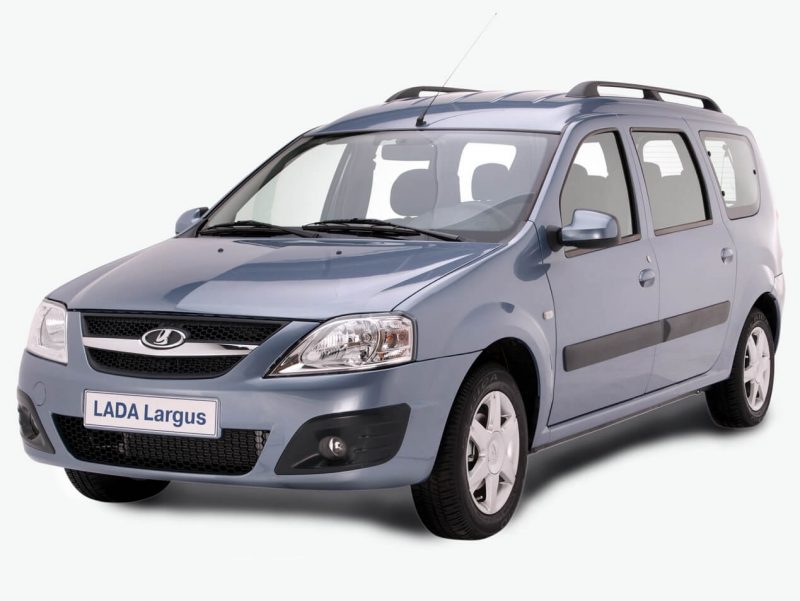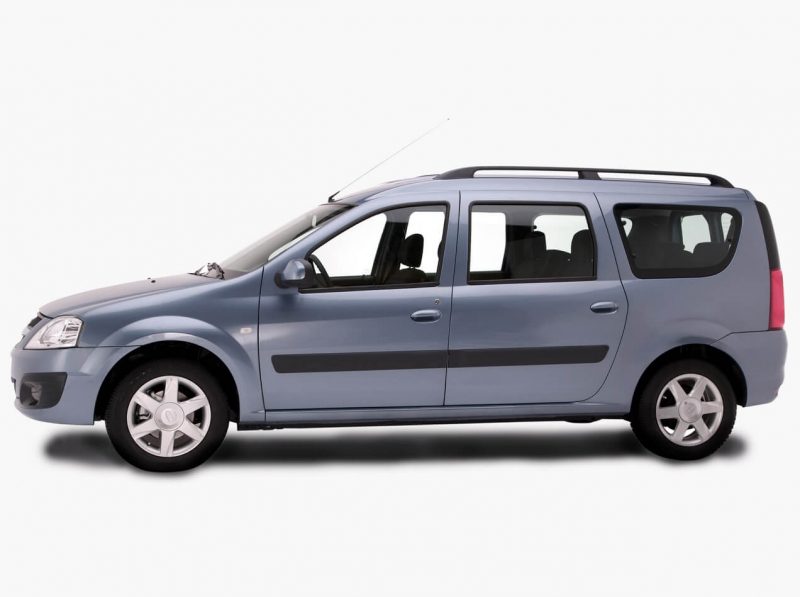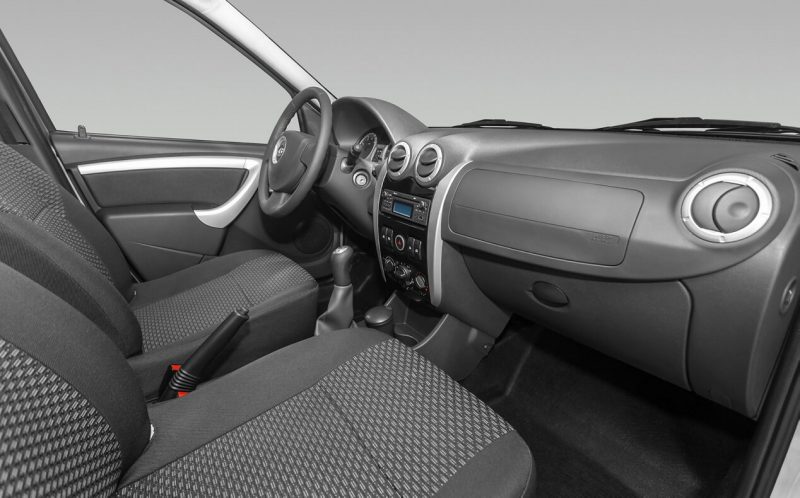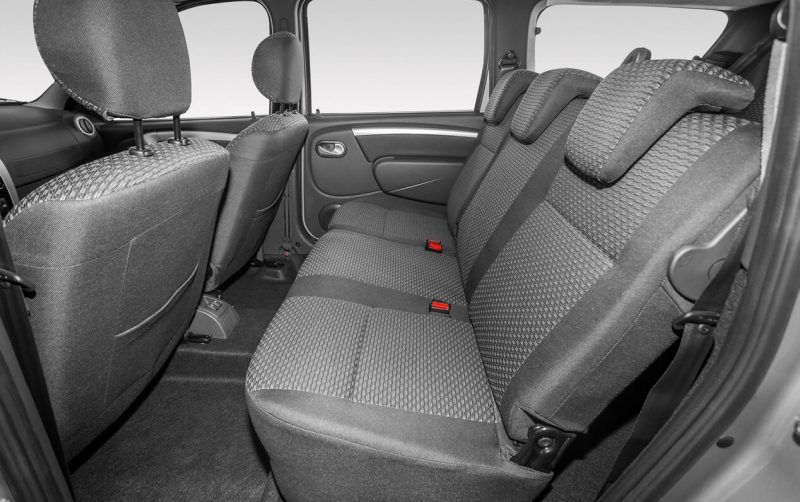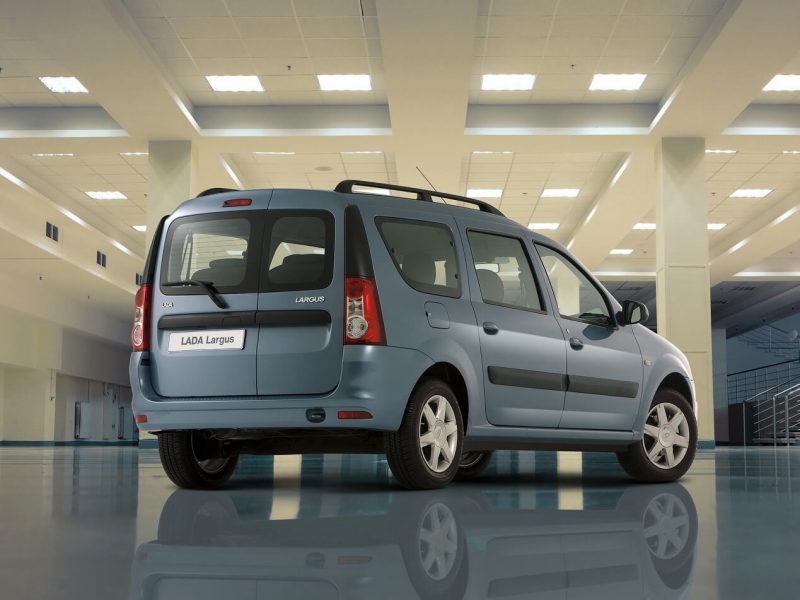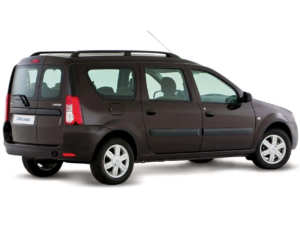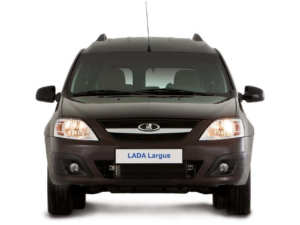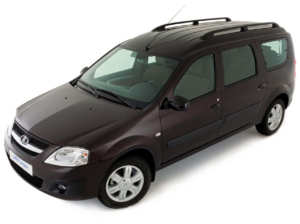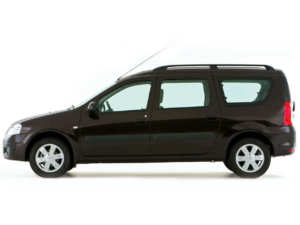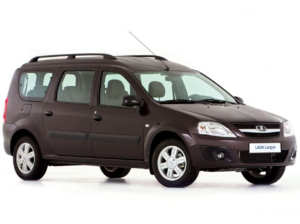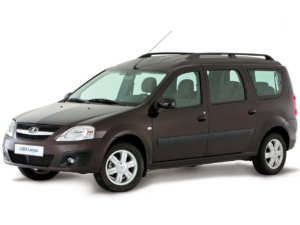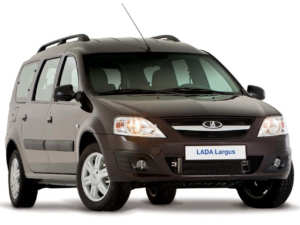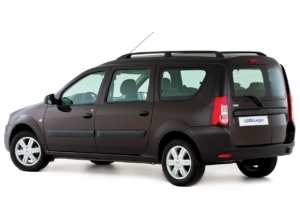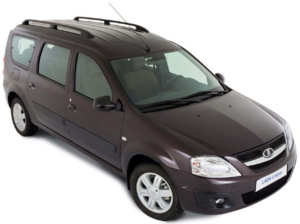Lada Largus
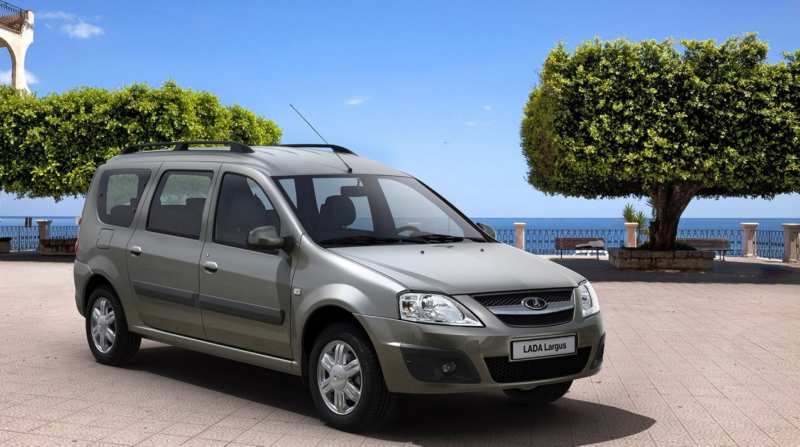
Lada Largus is a family of multi-purpose multi-purpose vehicles (MPV) market niche and the first joint development between AvtoVAZ and the French-Japanese union Renault-Nissan. The car is produced in the body of a van, compact van, station wagon and pseudo crossover). The whole model range is Lada.
- Exterior
- Interior
- Specifications
- Powertrain
- Transmission
- Running gear
- Safety
- Crash test
- Complete sets and prices
- Tuning
- Improvement of the powertrain
- Body Improvement
- Salon Tuning
- Comparison with competitors
- Reviews from the owners
- The pros and cons
- We sum up
- Lada Largus photo
- Test drive
- Video overview
Although the model is new for Russia, in reality it represents only slightly transformed (based on the words of AvtoVAZ company – adapted to domestic conditions of use) French-Romanian Logan MCV/VAN. The first model Largus left the conveyor plant in Togliatti on June 17, 2011.
But serial production of the vehicle started only in April 2012. It is worth noting that the domestic version of MPV has become one of the most actual Lada machines in our market. But the official history of the practical car began earlier – at the end of 2010. During the Moscow Motor Show the car was presented under the code name “Project R90”.
The first commercially produced car Lada Largus with the number “000001” turned out to be unusual. On its hood the signatures were put by the president of the Russian Federation Putin V.V. and representatives of Renault and Nissan.
Exterior
If you pay attention to the appearance of the universal Lada Largus, you can easily find out in it the exact similarity to the Dacia/Renault Logan MCV of the 1st family, except for small elements. Most similarities with the Togliatti brand can be seen on the front of the vehicle. And it doesn’t matter who is in front of us – the passenger version or the Largus van.
Chrome-plated horizontal line, which crosses the radiator grille, is supported by the branded “rook”. In addition, the front part has a modest optics and a bumper with soft patterns and “mouth” of the air intake. Front headlights look rather modest. Luxury equipment allows you to install fog lamps in black depressions.
Lada Largus is the most spacious Russian passenger car. The name of the car was also invented for a reason – in Latin it means “generous”.
If you look at the car from the side, it looks like the most common wagon from another manufacturer. There is a sloping hood, flat roof and large side windows. The side follows the design up to the door edge of the 2nd row Renault Logan sedan. The wheelbase is stretched.
Lada Largus is referred to the department of versatile vehicles and for the entire period from the beginning of sales and use the car has received a lot of good reviews. The height of road clearance is 175 millimeters, which should be enough for everyday use. However, you need to be careful when driving on rough terrain, especially if the car is loaded. The other dimensions of the Largus allow for the use of the wagon in many areas of life.
The back of the Lada Largus 2018 was given a huge cube-shaped stern. The stern looks pretty common. There are two asymmetrical swing doors that go deep into the bumper and the lighting columns, which are neatly made. Experts have not forgotten to equip the machine with a low loading height, which greatly facilitates the loading/unloading of luggage.
A rear windscreen wiper and a glass heating function are provided. The appearance of Lada Largus has not changed much, except for the new off-road versions. Interestingly, for Romanian motorists the 2nd family Logan MCV has already been presented. It is necessary to recognize that the appearance of the novelty in the near future on the territory of Russia is unlikely.
Perhaps the car will decide to update a little and not before the end of 2018. Based on the words of the manufacturer, the car will have some attributes of the new corporate style from Lada Vesta and XRay.
Interior
The interior of Largus 2017 is almost no different from that of Logan. The salon is ascetic and unremarkable. When viewing the dashboard and other elements, you can see the already existing ergonomic errors that are characteristic of Logan. The “dashboard” is succinct. There is a two-color display of the on-board computer and the dashboard scale, which received a chrome edging.
The whole dashboard is informative and does not distract the driver from driving. The steering wheel is big and fixed on 3 spokes, and also has height adjustments. In the center of the nameplate is painted “Lada”. The number of controls on the central panel is limited. Maximum equipment has a radio that supports AUX and USB connectors.
Initial and medium equipment instead of the radio received a simple plastic plug. Near the plug there are controls for ventilation and heating (there is an air conditioner and a stove). Between them there are keys from the electric drive of the windows installed on the front windows. There is also a rear door lock, rear window heating function and alarm system. The central console itself has a metal cover.
This machine was the first joint project of AvtoVAZ and the French-Japanese Renault-Nissan alliance.
As for the upholstery of the interior of Lada Largus, it was made of hard plastic and fabric. Seating places provide only a minimum level of comfort. The front seats are flat, there is side support, but it is minimal. But the arsenal of front seat settings is large.
The luxury version boasts lumbar support and height adjustment. The round air ducts of the ventilation system are surrounded by metalized rings. Passengers on the second and third row will not feel uncomfortable in terms of lack of free space. Three adult passengers will be glad to see the air ducts provided for them.
The roof does not cause oppressive thoughts, but it is necessary to notice that it is not so convenient to sneak on the third row of seats. However, it is important not to forget that the car was designed to transport cargo and passengers on a budget basis. It shouldn’t be too comfortable, and it performs its main tasks well.
Despite the cheap interior and cladding, everything is made quite solid and solid. If there is any extra noise or creaking from poorly fixed parts, they do not bother you as much as in other cars in this niche.
The trunk volume of the five-seater Largus model is 560 liters. This is the best result among officially available in Russia B-class cars in the body of a station wagon (as of 2014).
I would like to say separately for the trunk of Lada Largus 7. Modification of the car with 5 passenger seats has a useful space – 560 liters. If you add up the rear seats, the volume will grow to 2 350 liters. It turns out that it is possible to transport furniture, refrigerators and other bulky things without any difficulties.
Passenger modification with seven seats has 198 liters of volume, as well as the possibility of easy removal of the outer back row. This allows the vehicle to be used as a cargo carrier and to have the same spacious luggage compartment. The full-size “stock” is placed under the bottom and the luggage door can be opened in two asymmetrical 180-degree increments.
The Lada Largus Furgon version has a capacity of 2,500 litres and can carry 800 kilograms of cargo. The data is very impressive. There is nothing better for dacha owners, gardeners and small businesses.
Specifications
Powertrain
The Lada Largus cargo-passenger version has two gasoline atmospheric four-cylinder engines. In the role of “standard” is a 1.6-liter power plant VAZ-11189, which received a distributed injection system and eight-valve structure of the gas distribution mechanism. All this allows Lada Largus to produce 87 horsepower and 140 Nm.
Such “engine” allows to accelerate up to the speed mark of 100 kilometers per hour in 14.4 seconds. The maximum speed does not exceed 158 kilometers per hour. It consumes 83-horsepower engine of about 8.2 liters of gasoline per 100 kilometers.
More expensive complete sets have already 1.6-liter engine VAZ-21129, which received multipoint power supply, sixteen-valve gas distribution mechanism. The 16-valve Largus already produces 106 “horses” and 148 Nm. It takes 13.5 seconds to reach the first hundred, and the “maximum” is 165 kilometers per hour. In combined mode, the engine requires about 7.9 liters of fuel for every 100 km.
Although after its release, this versatile has not been updated externally, it has always been improved technically. For example, in December 2015, the vehicle was equipped with an 87-horsepower engine instead of the “Frenchman” Renault K7M with 84 horsepower. After August 2017, instead of the 102-horsepower atmospheric “engine” Renault K4M began to mount a Russian power plant designed for 106 horsepower (the engine was manufactured by VAZ plant).
Transmission
All motors only work with 5-speed mechanical gearboxes. All torque is transmitted only to the front wheels.
Running gear
This vehicle was based on the Renault-Nissan B0 front-drive platform. There are standard McPherson racks at the front and a semi-independent U-beam at the rear. The steering unit has a gear-rail circuit and is complemented by a steering booster (basic equipment does not include a hydraulic booster).
Ventilated disc brakes are installed at the front and drums at the rear as the brake system. The electronic system ABS is not supplied only for the standard version, but all other equipment has it by default.
Safety
Lada Largus 2018 is a modern car, so the specialists did not bypass the practical model in terms of safety. The latest generation of anti-lock braking system is available. The bodywork has been developed in such a way as to minimise injuries to passengers in the event of a collision.
All seats have three-point seat belts and head restraints. The driver and front passenger have front and side airbags. The Lada Largus 2018 fully complies with the current European passive safety requirements. This is a presence:
- Driver’s and passenger airbags;
- Front seat belts with force limiters;
- A front sub-frame that acts as an additional spar, absorbing and redistributing frontal impact energy;
- Three-point seat belts and head restraints;
- Anti-lock braking system;
- Systems of fastening of children’s seats ISOFIX;
- Indications of an unbuckled driver’s seatbelt;
- Cellular loose leaves in front door panels;
- Systems ERA-GLONASS.
Crash test
It’s hard to call a station wagon a new car. For those who have already bought this car, its known advantages and disadvantages. However, those who are just thinking about buying this model can be confused. Perhaps the Lada Largus crash-tests will help you get a more objective picture.
As with all vehicles, Lada Largus has been a mandatory crash-test runner. During the side test, a special trolley crashed into the car at a speed of 50 kilometers per hour. Such a test of the car has passed quite well. Because of the damage the car doors did not open.
The dummy, which was inside the car at the time of the study was 8 times lower than allowed. Speaking of pelvic damage, Largus copes with the tasks in accordance with these standards in three times the size. If we speak for the damage to the car after hitting it from behind, then Largus is not disappointed, as it perfectly provides protection from unnecessary injuries.
During the impact on the mobile barrier at a speed of 36 kilometers per hour, the inner part remained intact, the fixation of seats was preserved. Interestingly enough, the side windows, along with the glass of the boot rear door, were not damaged. Fuel tank is perfectly protected by “spare” and suspension parts. That’s why it remains intact during the crash-test.
Tests of the Lada Largus wagon have shown that the vehicle meets all legal safety requirements. Crash tests were carried out under more difficult conditions. The established rules of frontal collision testify to the impact at a speed of 56 kilometers per hour, and the VAZ test was conducted at a speed of 64 km/h, which is 8 kilometers per hour more than normal.
After the tests, the car got 8.32 points out of 10 possible, which is an excellent result, comparable to Logan MCV, which got 8 points in 2005. It turns out that it is possible and even necessary to buy a Lada Largus station wagon.
Complete sets and prices
For the Russian market, Lada Largus 2018 is offered in 3 configurations: Standard, Norma and Luxe. Standard” assembly costs $8213 and has an eight-valve power unit K7M with a 5-speed mechanical box JH3, as well:
- A driver’s airbag;
- Seat belts for the driver and adjacent passenger with limiter function;
- Clamps for child seats;
- Vacuum booster brake system;
- The mechanical corrector of illumination of optics;
- Inertial belts of safety (5 pieces);
- Headrests on back armchairs;
- Blocking of doors from opening by children;
- The immobiliser;
- An upholstery of seats from a fabric;
- A plastic upholstery of salon;
- Hair mats in the cabin and trunk;
- The bracket for fastening of cargoes;
- Adjustment of a steering wheel on an inclination;
- Lighting in the trunk;
- Alarm clock on position lights not switched off;
- Single ignition key and doors;
- Audiopreparation;
- The pressed 15-inch “skating rinks”;
- Electronic systems ABS and EBD;
- 12V socket outlet;
- The air filter of salon;
- Easy toning;
- Railings
- Full-size spare wheel.
Next comes the execution of “Norm”, which is estimated at $ 8519. It has a presence:
- A sun visor with a front passenger mirror;
- Possibilities of unfolding the passenger seat in the ratio of 60:40;
- The hydraulic amplifier of a steering wheel;
- Adjustment of seat belts on height;
- The central lock;
- Glass elevators with electric drive on the front windows;
- Colours of a bumper in one tone with a body;
- Moldings on the side doors.
The “Norm” version has additional packages of options “Climate” and “Control”. The price will be higher – 8863 $. In “Climate” you can see the presence of air conditioner and front seats with heating. Comfort” has already installed an airbag for the front passenger with the function of its deactivation, luggage compartment, luggage compartment, luggage compartment, as well as audio system with a pair of speakers.
I already got the “Lynx” version:
- It’s a two-tone beep;
- Onboard computer;
- Fabric inserts on an upholstery of doors;
- Chrome elements in internal furnish;
- Leather covering “a steering wheel”;
- Possibility to adjust a driver’s seat with lumbar support on height;
- Cigarette lighter with ashtray;
- Pockets on the front seats;
- Central lock with remote control;
- Electric windows on the rear windows;
- Electrically powered exterior mirrors with electric heating function;
- Painting of door handles and overlays on mirrors under body painting;
- Thresholds on front doors;
- Fog lamps;
- 15-inch cast “rollers”;
- Audio system with four speakers;
- Front and rear parking sensors;
- Parktronic.
You’ll have to pay at least $9923 for this option. There is also a model that received not cast, but stamped wheels.
Tuning
The Lada Largus car turned out to be a practical model and from the start of sales it became a great success with car owners. The car is notable for a good build quality, but the appearance is not the most successful. The domestic car gave priority to rigor and practicality in favor of stylish design. Therefore, many car owners of Lada Largus will decide to improve their appearance using tuning.
Improvement of the powertrain
When considering the tuning options for the Lada Largus, it is advisable to focus on the technical part first. Special attention should be paid to the powertrain. “The engine can develop from 84 to 102 “horses”, depending on what design solutions are used in this car.
For daily trips in the city environment the engine power is enough, especially if there is a family. But there are many owners of Lada Largus, who are not satisfied with the capabilities of their engine. Therefore, there are 2 ways to improve the power of its power plant:
- Make chip-tuning to the electronic control module, after which the settings will be changed;
- Perform mechanical modification of the motor, which implies productive intervention with the task of replacing elements with similar components of a more enhanced plan.
If to speak for the first way – chip-tuning, it is widespread enough and enjoys success with many car owners. The meaning of the improvement is to change the ECU settings. As a result, it is possible to achieve adjustment of the engine. If to calibrate correctly certain parameters it is possible to expect a worthy award – power increase.
The best chip tuning is performed in specialized workshops. They can reprogram the standard firmware version to another one. As a result:
- Fuel appetite is declining;
- Toxic emissions are reduced;
- Dynamic performance increases.
It is also possible to resort to mechanical conversions of the power plant. This implies a significant improvement in performance (plus approx. 10-40 percent of the basic parameters). These conversions are performed by replacing some elements in the motor. This can include:
- Fuel supply system;
- Elements of the hydraulic fracturing system;
- Injection components;
- Cylindrical piston group and block head elements.
It is important to note that parts must only be replaced with identical parts that are structurally compatible with the motor.
Body Improvement
If the owner of “Lada” is not delighted with the exterior of the body, you can transform the exterior of his “swallow”. Many people at the moment are inclined to 2 variants of work:
- Carry out structural modernization of body components;
- Make a cosmetic revision.
For the first version, some body parts are replaced with newer ones. Often these elements are individually designed. It is important that if the exterior of the Lada Largus can be transformed qualitatively and skillfully, its aerodynamic data can be improved. Some drivers decide on:
- Spoiler installation;
- Installation of the cover on the hood;
- Replacement of front and rear optics with more modern ones;
- Installation of various elements of reinforcing type (front grille, protective covers, skirts and so on);
- Installation of fresher “rollers”;
- Replacement of bumpers, external mirrors, etc.
Of course, such manipulations require a lot of money and free time, but the result will please the owner for a long time. Simpler tuning includes cosmetic improvement of the exterior. It is possible:
- Update the paintwork bodywork;
- Tint the windows;
- To make drawings of aerographic type on body panels;
- Glue the body with different polymeric materials (carbon, vinyl and so on);
- Apply additional LED lighting sources.
Salon Tuning
That’s where we can put it:
- Replacing the covers with new ones with a more interesting design, or installing new seats instead of base seats;
- Panel coverings with fresher materials;
- Replacing the “steering wheel” with similar variants with a sports bias;
- Installation of the armrest;
- Replacement of door handles with similar ones with its own lighting;
- Application of noise insulation.
You can also install speakers, a subwoofer, a TV set, etc., which increases the level of comfort. Improvements can also affect the suspension by using reinforced parts, increasing or decreasing ground clearance, installing shock absorbers and stabilizers with increased data, and more.
Comparison with competitors
Although the Russian model Lada Largus 2018 does not have a huge number of opponents in its class, they do have them. The model will fight for the attention of consumers with Peugeot Partner, Citroen Berlingo, Renault Kangoo, and Volkswagen Caddy.
Speaking for Renault and Citroen, they received 460 liters more luggage compartment, so they remain at a considerable distance. However, they do not have the same high payload. The Renault version has 3,000 litres of usable space, including the folded rear seats, which is also a lot.
Load capacity is higher than that of Citroën and Peugeot, but the options for transforming the interior are clearly losing. As for the German version of Volkswagen, it does not have an abundance of options for transforming the cabin, but the volume of the boot is higher by 200 liters of the closest rivals. Despite the fact that the power plant is as economical as the French variants, the engine develops by 20 “horses” more.
In terms of payload the model slightly loses to Ladet, but Cuddy is the strongest, capacious, equipped and diverse. Volkswagen has versions even with all-wheel drive system. Not without a full-fledged crossover modification Cross Caddy.
Reviews from the owners
Based on the feedback from the owners of Lada Largus, it can be concluded that many drivers are satisfied with their car. The advantages of the model include good capacity, acceptable height of road clearance, seven-seater variant, low cost, reliability and spacious luggage compartment. The exception is the version with seven seats, where there is almost no space for luggage.
I am glad that there are rails on the roof for transportation of various bulky goods. Owners of Lada Largus note the convenience of rear swing doors. The rear row of seats can be folded out. If necessary, it can even be used for overnight stays. There are massive external mirrors, which, unfortunately, have not received an electric drive adjustment. The gearbox is perfectly engaged, softly and without jerks.
The absence of an on-board computer is a little frustrating, as there is a lack of useful information about the vehicle. The disadvantages include poor quality assembly, an abundance of defects, defects, defects, high fuel consumption, large size and no less than a large turning angle, heater, low dynamics, weak power unit and ergonomics.
The quality of plastic leaves much to be desired. Maneuverability and smooth running suffer. The owners of the Lada Largus wagon do not like low noise isolation, rigid suspension and expensive maintenance.
The pros and cons
Pluses cars
- Pretty nice appearance;
- The height of the ground clearance;
- There are various updatings;
- Convenient back hinged doors;
- Functional interior;
- The huge luggage branch which can be raised if to summarise back seats;
- Small cost;
- High ceiling;
- Good loading height;
- There are useful options (heating of seats and other);
- Many useful compartments for storage of trifles;
- The forward drive;
- Convenient and clear dashboard;
- There is a hydraulic amplifier of a steering wheel.
Cons of a car
- Weak powertrain;
- Low dynamics;
- Excessive fuel consumption;
- Large size and turning radius;
- Poor quality assembly;
- Cheap materials for interior decoration;
- Low level of comfort;
- Rigid pendant.
We sum up
In conclusion, I would like to say that the union of the domestic automobile company with foreign companies had a positive impact. Initially I would like to note the fresh look and rich functionality. Besides, Lada Largus stands out by its spacious interior and large luggage compartment. Inside it is not so comfortable, as at the European competitors, but also the price list on the given universal is a little bit lower.
The engine does not always have enough power, so it often has to be twisted, which results in higher fuel consumption. Noise insulation is mediocre. The quality of the plastic used inside the machine is low. The suspension is rigid and the turning angle is very large. There are various modifications to choose from, including a seven-seater version.
Safety is a pleasant surprise, so this car can be safely recommended not only for dacha owners, but also for families. Therefore, if you need an inexpensive, simple, functional, spacious and unprivileged car – Lada Largus will be the best choice.
We advise you to read the article: AutoVAZ history – LADA cars


